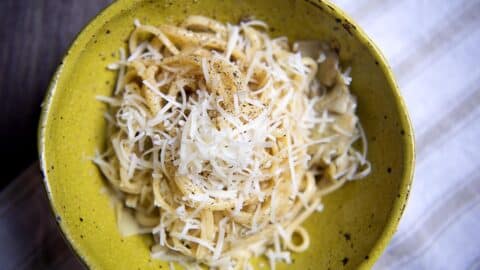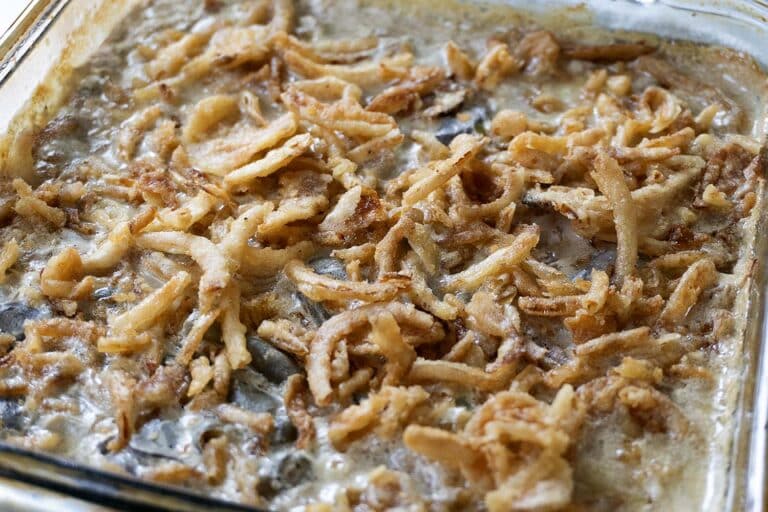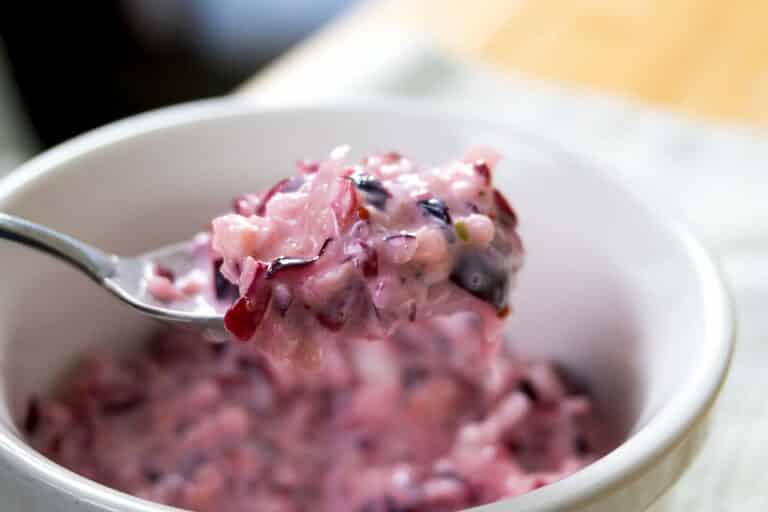Artichoke Carbonara Recipe
This artichoke carbonara recipe is decadent, creamy, and everything you want in one bowl! Oh, it’s also super easy to make!

Pasta carbonara is a traditional Italian meal that has been loved for many years. It’s a hearty and filling dish that’s typically cooked with eggs, cheese, and bacon. It’s ideal for any occasion. Have you ever attempted to make carbonara as an Artichoke Carbonara Recipe, though? Your taste senses will swoon over the delightful and surprising flavor this original addition to the traditional recipe brings.
Ingredients:
- 1-pound spaghetti
- 2 minced garlic cloves
- 1 can of chopped and drained artichoke hearts
- 2 eggs
- grated Parmesan cheese, half a cup
- To taste, add salt and pepper.
- freshly cut parsley (optional)
Directions:
- Cook the spaghetti until al dente following the directions on the package. Drain the remaining pasta water, reserving 1 cup.
- In a large skillet set over medium heat, add the garlic and sauté.
- Cook the chopped artichoke hearts in the skillet for two to three minutes, or until cooked through.
- Whisk the eggs and Parmesan cheese together thoroughly in another basin.
- Cooked spaghetti should be added to the skillet with the artichokes. Combine by tossing.
- Pour the egg and cheese mixture over the spaghetti after turning off the stove.
Season with salt and pepper to taste and sprinkle with fresh parsley, if desired.

A tasty and distinctive variation on the traditional pasta meal is this artichoke carbonara recipe.
The richness of the bacon and Parmesan cheese is complemented by the acidic, slightly sweet flavor that the artichokes bring to the dish.
The recipe is also quick and simple to make, making it a fantastic choice for a hectic evening meal.
When adding the egg and cheese combination to the pasta in this dish, it’s crucial to ensure the skillet has been taken off the heat. The dish’s creamy quality will be ruined if the eggs scramble due to the skillet heating up too soon.
All things considered, anyone who like the traditional meal but wants to add a little something special should try this artichoke carbonara recipe.
This dish will undoubtedly become a new favorite in your recipe collection because it is tasty and filling.
What Is The Golden Rule of Cooking Carbonara?
The first rule of making carbonara is that you should never add eggs to hot pasta that is still cooking. Instead, turn off the heat and let the pasta cool for a few seconds before adding the eggs.
This guideline is in place because if eggs are placed in hot pasta, they will start to cook and scramble right away, giving the dish a lumpy and unpleasant texture. The temperature will drop just enough after removing the pasta from the burner so that the eggs can cook slowly and produce a creamy sauce.
In another bowl, combine the eggs, grated Parmesan cheese, and black pepper to combine. When the pasta is finished cooking and draining, add it to the skillet along with any additional ingredients, such as bacon or pancetta, and mix well.
After that, turn off the heat under the skillet and quickly toss the pasta in the egg mixture to ensure that it is equally coated. The eggs will be cooked by the remaining heat, which will also produce a creamy sauce that perfectly covers the pasta.
According to this golden rule, you can make sure that your carbonara will be tasty, creamy, and free of any visible scrambled eggs.
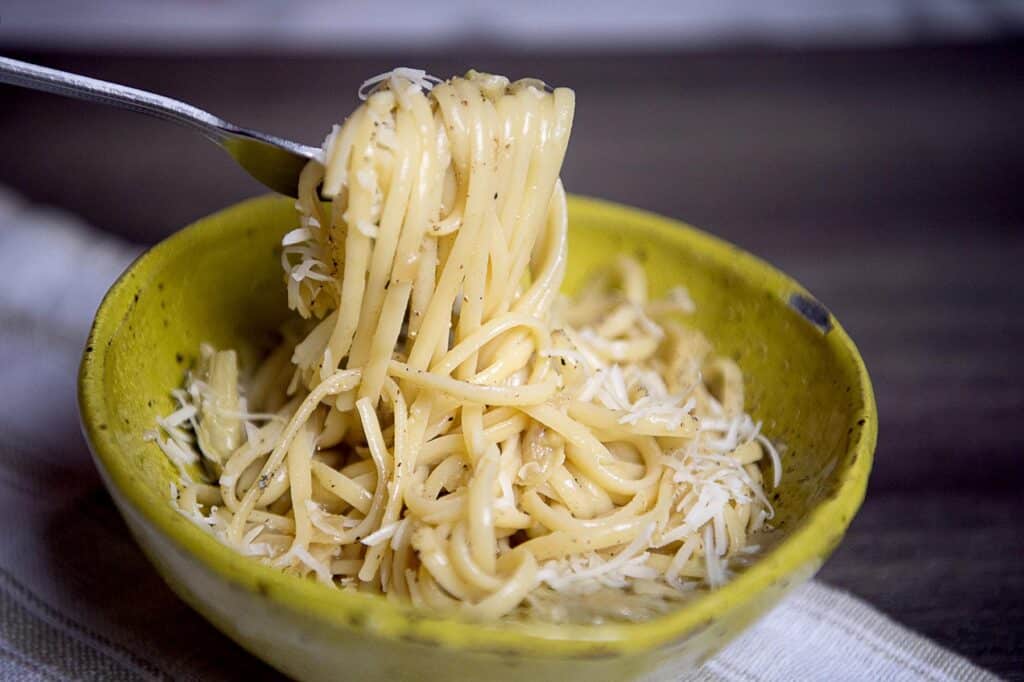
What Should Not Be Added To Carbonara?
A traditional Italian pasta dish called carbonara is prepared with eggs, cheese, bacon or pancetta, and black pepper. While the fundamental recipe can be altered and enhanced in a variety of ways, some ingredients shouldn’t be included because they might change the dish’s distinctive flavor and texture.
The following components shouldn’t be included in carbonara:
- Cream: Although cream is not normally used in the recipe, carbonara is supposed to be a creamy pasta dish. The cream will make the sauce excessively thick and heavy and dilute the flavor of the eggs and cheese.
- Garlic or onions: While they can flavor many foods, they are not appropriate with carbonara. The delicate aromas of the eggs and cheese may be overwhelmed by the potent flavors of these ingredients, resulting in a dish that is overly thick and heavy. If you’re looking for a garlic and onion heavy pasta, try this kale pesto pasta.
- Chicken: Pancetta or bacon are typically used to make carbonara; chicken is not a viable alternative. The dish will lose its authentic Italian flavor since the chicken’s flavor and texture will clash with the creamy sauce.
- Vegetables: Peas and other vegetables may be used in some carbonara recipes, although they are not conventional and should only be added in little amounts. Vegetables, which can alter the dish’s texture and flavor, are not frequently used in true carbonara recipes.
You can make sure that your carbonara stays true to its traditional Italian roots and maintains its rich, creamy flavor by omitting these items.
What you could add to this dish to make it more meat forward, would be this tasty
You can make sure that your carbonara stays true to its traditional Italian roots and maintains its rich, creamy flavor by omitting these items.
What you could add, if you’re looking for a more meat forward dish, would be this authentic bolognese sauce. If you’re looking for another vegetarian pasta dish, try this cottage cheese pasta.
What Is The Secret To Making Carbonara?
Achieving the ideal texture and ingredient balance is key to creating the ideal carbonara. Here are some pointers to help you perfect the carbonara recipe:
- Use the greatest ingredients you can find: Carbonara is a straightforward recipe, therefore it’s critical to use the best ingredients you can. Choose fresh, free-range eggs, premium Parmesan cheese, and bacon or pancetta of a high caliber.
- Cook the pasta until it’s al dente: Spaghetti or another kind of long, thin pasta is traditionally used to make carbonara. To ensure that the pasta has the proper texture and doesn’t get mushy, it must be cooked al dente (stiff to the biting).
- Keep the pasta and sauce separate until the very last minute: It’s critical to maintain the pasta and sauce separate until the very last minute to avoid the eggs scrambling. Drain the cooked pasta and give it a moment to cool before adding it to the sauce.
- Make the sauce using the pasta’s cooking water: A smooth and creamy sauce is made possible by the starchy pasta cooking water. When you have the right consistency, add a cup of the reserved pasta boiling water gradually to the sauce.
- Use the proper number of eggs: A creamy carbonara sauce is ideal, but it shouldn’t be overly runny or thick. Use the appropriate number of eggs to make the appropriate amount of pasta, which is typically one egg for each person plus one extra for the pot.
- Black pepper is a typical seasoning for carbonara because it gives the dish a somewhat peppery flavor that offsets the richness of the eggs and cheese. Add black pepper to taste.
You can make a tasty and authentic carbonara that will delight your taste buds and surprise your guests by using the advice in this article.
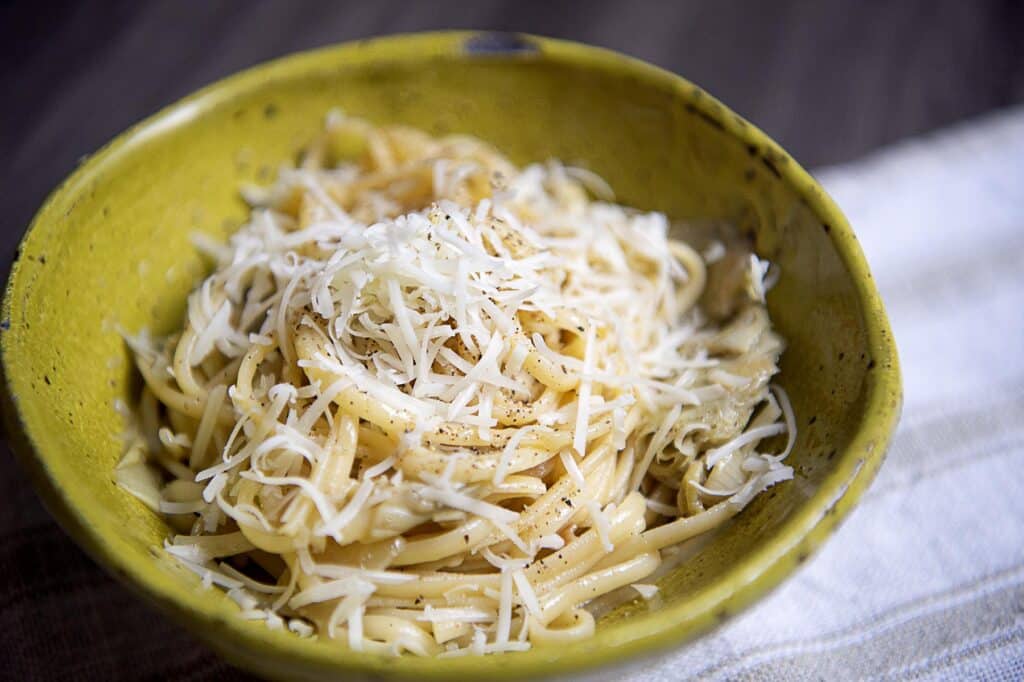
Is Alfredo Sauce The Same As Carbonara?
No, carbonara and Alfredo sauce are not interchangeable. Both are creamy pasta sauces, but they come from different places and have different flavors and ingredients.
A traditional Italian-American sauce made with butter, cream, and Parmesan cheese is called Alfredo sauce. Alfredo Di Lelio, a chef from Rome, created the sauce to sate his pregnant wife’s yearning for an easy-to-make but filling pasta meal. The sauce’s moderate flavor and rich, creamy texture go well with a variety of pasta recipes.
The traditional Italian pasta dish carbonara, on the other hand, is cooked with eggs, Parmesan cheese, and pancetta or bacon. The dish’s sauce is made by combining beaten eggs with grated Parmesan cheese, black pepper, and the Lazio region of Italy.
The eggs are cooked by the heat from the pancetta or bacon and cooked pasta, resulting in a rich, creamy sauce that nicely covers the pasta.
While both carbonara and Alfredo sauce are creamy pasta sauces, they differ in their flavor profiles and ingredient combinations.
Whereas carbonara is creamy, salty, and only somewhat spicy due to the black pepper, Alfredo sauce is rich and mellow.
While both recipes are excellent, it’s crucial to remember that carbonara is a more classic Italian dish and Alfredo sauce is an American innovation.
Why Is The No Cream In Carbonara?
Traditional carbonara does not contain cream since it is intended to be a straightforward, rich, and savory pasta dish that emphasizes the eggs, cheese, and cured pig.
The eggs and Parmesan cheese are combined to form an emulsion that gives the sauce its creamy texture and gives the pasta a smooth, silky coating. The heat from the pasta and cured pork cooks the eggs, resulting in a rich, velvety sauce with a depth of flavor that cream cannot match.
Cream would overpower the flavor of the eggs and cheese in carbonara and make it overly thick and heavy. However, the addition of cream would change the dish’s typical flavor and consistency, emulating Alfredo sauce, a whole distinct pasta dish.
Generally, the traditional preparation of carbonara and the harmony of its flavors depend on the absence of cream. Carbonara is a traditional Italian pasta meal that just calls for eggs, cheese, cured pork, and black pepper. It is adored for its simplicity and distinctive flavor combination.
How Do You Make Carbonara Taste Better?
Even while carbonara is already a tasty and flavorful dish, there are some techniques you may employ to improve its flavor:
- Use high-quality pancetta or bacon, fresh eggs, and Parmesan cheese.
- Avoid overcooking the pasta because it will spoil the dish’s texture and taste mushy. The pasta should be cooked until it is al dente, or slightly chewy.
- Employ freshly cracked black pepper: Compared to pre-ground pepper, freshly cracked black pepper has a richer flavor and scent. Just before serving, sprinkle black pepper over the pasta to add flavor.
- Add garlic: Garlic isn’t typically used in carbonara, but it can give the meal a lovely depth of flavor. Before adding the pasta, sauté some chopped garlic in the pancetta or bacon oil.
Use the pasta water: The starchy pasta water can aid in the production of a creamy sauce and the unification of the dish. Before draining the pasta, save some of the water and, if necessary, use it to thin the sauce.
Add some fresh herbs: Just before serving, add some fresh parsley or basil to the dish for a beautiful splash of color and flavor.
You can improve your carbonara and make it even tastier by using these suggestions.
What Is The Best Pasta For This Artichoke Carbonara Recipe?
Spaghetti is traditionally the ideal pasta for carbonara. The spaghetti’s long, thin shape allows the creamy, rich sauce to coat the pasta evenly, producing a delightful and filling meal. Nevertheless, linguine and fettuccine are just two examples of long, thin pasta designs that can be effective.
Choose a spaghetti shape that can withstand the richness of the sauce without becoming overly clumsy. Short pasta forms like rigatoni and penne should not be used since they can be too heavy and dominate the delicate tastes of the meal.
If you want your pasta to hold up to the sauce and have a firm texture, choose a premium brand that is prepared with durum wheat semolina. To ensure that the pasta can absorb the sauce without turning mushy, cook it until it is al dente, or still has some bite.
- 1 lb spaghetti
- 2 minced garlic cloves
- 1 can chopped artichoke hearts
- 2 whole eggs
- 1 cup grated parmesan
- 1 tbsp salt and pepper to taste

